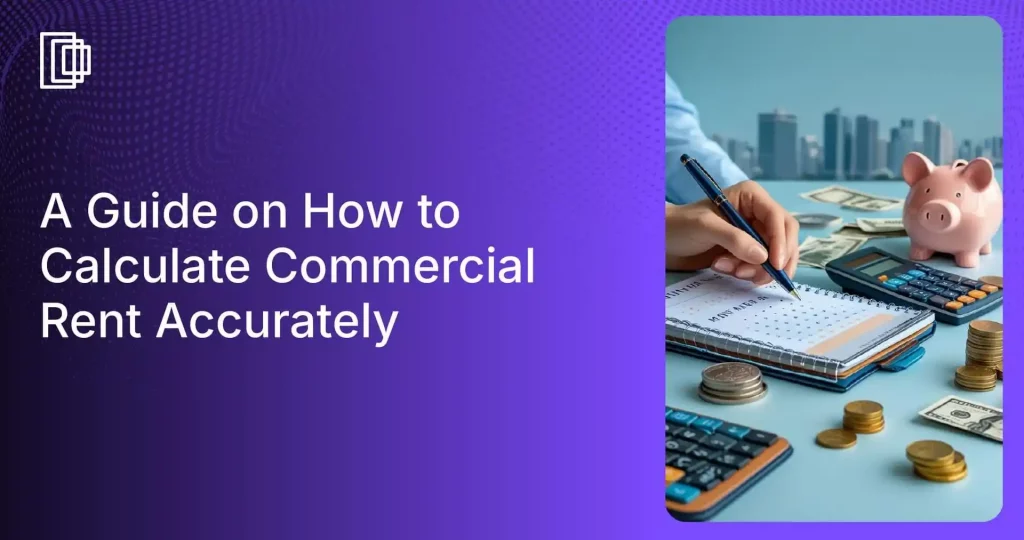Commercial leases are the new best friend of any physical business. Instead of purchasing a commercial space or renting it on a monthly basis, you can draw up an ongoing contract that benefits both the lessor and the tenant greatly over the long run.
Most people are daunted by the commercial rent calculation for commercial real estate and this is mainly because of the variables associated with it. As of 2022, the rent for commercial spaces has experienced a spike of 2-3% based on the location. Understanding how to calculate commercial rent is crucial for your business’s financial health.
Based on whether you have a net lease, a double net lease, a triple net lease, a gross lease, or a percentage lease, the monthly rent varies and so does any increase levied upon the property.
Hence, today we need to discuss these variables that you need to consider and the types of commercial leases that affect the rental rate, so you can make better decisions to rent your commercial real estate. You will see how to calculate commercial rent based on the types of rental properties you choose by paying little attention to these variables from the start.
What are the different types of commercial real estate that you can acquire on a lease?
There are a number of commercial tenants who prefer renting the entire building, however, some opt for specific units to restrict their payments to the parts that they will utilize. In the latter case, a tenant pays the rent amount based on the total square footage, the common area that they utilize, and in the cases of an NNN lease, the insurance and property taxes for said commercial space.
Here are a few types of commercial rental properties that you can acquire with help from commercial real estate professionals:
- Retail space
- Limited or shared Office space
- Office building
- Shopping malls
- Strip centers
- Industrial properties
The gross lease to be paid for each of these rental properties is directly contingent on the commercial space your company occupies and the type of lease agreement you have with the property owner.
For instance, in the case of NNN leases, the monthly rent amount will be lower than a rental agreement that is not a lease. However, you will have to pay for any repairs in the rented space, common area maintenance, property taxes, property insurance, and additional charges levied for the usage of utilities separately.
On the other hand, if you have a full-service lease then your base rent will be inclusive of all these additional charges minus the utility costs that are incurred by the company as per usage.
Therefore, if the costs for repairs and maintenance of the commercial space or common areas are more than agreed upon, you are not obligated to pay huge additional charges since the base rent will cover a part of these expenses.
How is commercial lease calculation undertaken to decide the monthly rent?
The commercial tenant and building owner will have to agree upon the type of lease agreement and the charges that are included and precluded from the monthly rent prior to drawing up the contract for the lease. Here are the types of rental agreements offered by commercial real estate owners:
1. Rent based on usable square feet
Often, owners and tenants come to an agreement about the base rental rate depending upon the type of business plan and load factor that the tenant presents when applying for the lease.
The owners subsequently determine the actual amount for the rent based on the usable square footage available in the commercial space that the tenant wants to occupy.
There are two types of calculations when you’re pondering over how to calculate commercial rent, and they are based on the rentable square feet:
a) Annual rent
It is calculated based on a simple equation of rentable square footage multiplied by each unit of usable square feet available. This is the easiest method of applying for a commercial lease as the tenant only needs to pay for the amount of tangible space that they can use.
| For instance, if the price per square foot is $10 and the total square footage of the unit is 1000 square feet then the gross rent would be $10 x 1000 = $10,000. |
Large businesses and successional business models find it easier to subscribe to an annual rent as it is a one-time payment which makes it simpler to determine their yearly profits during the turnover.
Additionally, tenants can negotiate a fully-serviced lease for an annual rent because they pay a lump sum amount to the property owner which is beneficial to both parties.
The tenant is free from the stress of having to account for the rent of the commercial space from the monthly revenue, whereas the property owner receives a huge sum of money that they can subsequently deposit into a bank and earn returns.
b) Monthly rent
| It is calculated by dividing the annual rent by 12. Therefore, leading with our example of $10 as rent per square foot of the property and 1000 square feet worth of tangible commercial space, the rent would be calculated as $10,000 / 12 which is $833.33 per month |
Small businesses and new ventures find this to be more beneficial because their business models are uncertain. If the tenant’s business goes under, they can simply terminate the contract and the property owner refunds their security deposit.
If there is a clause stated in the initial rental agreement stating that the building owner charges a certain sum for early termination of the contract, then this amount can be calculated based on the lease terms of the commercial lease agreement.
It is a matter of simple subtraction of the percentage of the money owed to the commercial property owner from the total security deposit.
These lease agreements usually mention additional operating costs and maintenance for the lobbies, restrooms, and the occupancy of the building’s common spaces in general.
The tenants must bear these additional costs but they can work out an agreement wherein the common area maintenance and operating expenses for the facilities are shared by all the tenants in the entire building, or at least the ones on their floor.
Most of these shared office spaces are leased to two or more firms that are treated as separate entities when it comes to usable floor space, however, they are equally liable to pay for the common areas and the utility and maintenance bills pertaining to them.
2. Percentage rentals
Another type of contractual agreement is where the property owner is entitled to a percentage of the tenant’s gross business profits.
If the location of the commercial space is ideal for receiving considerable foot traffic and poses an opportunity for growing the revenue of the business as a byproduct of the placement of the commercial space, the owner is well within his or her rights to negotiate a percentage of the income.
The company occupying the commercial real estate can bargain for a fair price and the two parties must agree upon the lease terms before signing the document. The company must then pay the aforementioned percentage of its profits as part of the rent.
In other words, the owners receive a base rent for the commercial real estate plus an additional income as a bonus for allowing the tenants to utilize prime locations.
There are two distinct methods of calculating a percentage rental rate:
a) A percentage over a certain base profit
In these percentage rental rates, the owners devise a rental plan that includes base rent and a percentage of the profit above a certain amount that is previously agreed upon by both parties.
Simply put, it is base rent plus an additional percentage of the total profits, only if the tenant’s business makes more than a predetermined revenue.
| Let’s assume that the commercial rent of the property is $300 per month and the owner has specified a base profit margin of 10% over $10,000 in business profits. Therefore, if the business makes $25,000 in gross profits then the calculation would be, 300 + (25,000 – 10,000) x 10%. |
So, the tenant pays an additional 10% for the $15,000 extra profit they earned against their estimated revenue. Thus, the total commercial rent for that month would be $1800, which is $300 in base rent and $1500 as a percentage of the increased profits.
b) A percentage of the gross profit
Another method of percentage rental rate is when the owner specifies that the tenant must pay the base rent and an additional flat percentage of their gross profit, regardless of how much they make.
Therefore, using the previous example, the commercial lease calculation would be,
| 300 + 10% x 25000 = $2800, wherein the base amount of $10,000 is not included in the calculation. The tenant pays a percentage of their gross profit regardless of whether they earn $25000 or $250 in revenue. They will have to pay $2500 or $25 depending on their profits as additional lease payments. |
How to Calculate Commercial Rent?
The commercial tenant and building owner must agree upon the type of lease agreement and the charges included and precluded from the monthly rent prior to drawing up the contract. Mastering how to calculate commercial rent involves a few key steps. Let’s break down the process to make it simple and clear.
Step 1: Calculate Your Annual Base Rent
First, you need to understand a few key terms before you can learn how to calculate commercial rent.
- Price Per Square Foot ($/SF): The landlord’s quoted price for the space.
- Usable Square Footage (USF): The actual, exclusive space you will occupy.
- Rentable Square Footage (RSF): Your usable space plus a percentage of the building’s common areas (lobbies, hallways, restrooms). This is usually the number used for rent calculation!
Then, you can use a clear formula for the actual calculation. A key part of knowing how to calculate commercial rent is this initial equation:
- Annual Base Rent = Price Per Square Foot × Rentable Square Footage (RSF)
For instance, if the price per square foot is $25 and the total rentable square footage is 2,000 square feet, then the gross rent would be $25 x 2,000 = $50,000 in Annual Base Rent.
Step 2: Add Additional Rent (The “Nets” or CAM Fees)
For many leases, especially Triple Net (NNN) leases, the base rent is just the beginning. You also have to account for additional operating costs. A critical part of calculating commercial rent is factoring in these extra fees.
- What are CAM Fees? Common Area Maintenance (CAM) charges are fees paid by tenants to the landlord to help cover costs associated with overhead and operating expenses for common areas. These can include landscaping, security, parking lot maintenance, property taxes, and insurance.
- Your share is usually calculated based on the percentage of the building you occupy. This is a vital step in the process of how to calculate commercial rent.
Here is the formula to find your total annual cost:
- Total Annual Rent = Annual Base Rent + Annual NNN/CAM Fees
For example: $50,000 (Base Rent) + $10,000 (CAM/NNN) = $60,000 Total Annual Rent.
Step 3: Convert to Your Monthly Rent
The final step in how to calculate commercial rent is breaking down the annual figure into a monthly payment. This is a simple but necessary step to include for budgeting purposes.
The formula is:
- Monthly Rent = Total Annual Rent / 12
Using our example: $60,000 / 12 = $5,000 per month. Small businesses and new ventures often find this monthly model more beneficial because their business plans can be uncertain.
3 Main Types of Commercial Leases
The process of calculating commercial rent is directly impacted by your lease type. Based on whether you have a net lease, a double net lease, a triple net lease, a gross lease, or a percentage lease, the monthly rent varies. Here are three of the most common types:
- Triple Net Lease (NNN): In NNN leases, the monthly base rent is lower, but you pay for property taxes, insurance, and common area maintenance separately. This lease type requires a careful approach to how to calculate commercial rent to account for all variables.
- Modified Gross Lease (MG): This is a compromise. The base rent includes some of the operating expenses, but not all. The tenant and landlord agree on which costs the tenant will cover. This flexibility can affect how to calculate commercial rent.
Full-Service Gross Lease (FSG): With a full-service lease, your base rent includes all operating expenses. This is the simplest option for tenants, though the base rent is higher. Your landlord handles the taxes, insurance, and maintenance.
 Conclusion
Conclusion
The commercial lease calculations are actually easy when the terms of the lease clearly specify the method of payment and any additional rental percentage from the start. If you have to pay the property taxes, operating expenses, and property insurance as required by net lease agreements, they will be incurred separately.
Therefore, you need not worry about them while calculating your commercial rent. You simply need to estimate the net usage of utilities and a median cost for additional charges to add to your monthly expenditure on the commercial property.
Go through the fine print to determine any clauses that can favor your rental rate and discuss it with the property owner before coming to a mutual agreement on the base amount as well as any surcharges or percentage charges.
To visualize how the space will look and how much space you really need, sign up for Foyr Neo’s 14-day free trial and get a crystal clear idea about it.
Frequently Asked Questions (FAQs)
1. How to calculate commercial rent escalations?
Rent escalations involve periodic increases in rent, typically tied to inflation or predetermined percentages.
2. What financial documents should you prepare when negotiating commercial rent?
You should prepare a comprehensive financial statement, including income, expenses, and projections. This documentation helps demonstrate the business’s financial stability and provides a basis for negotiating more favorable rent terms.
3. How can you assess the overall affordability of a commercial space?
In addition to rent, you should consider other operational costs such as insurance, maintenance, and potential renovations. Evaluating the overall affordability requires a comprehensive analysis of all expenses associated with the space.
4. In shared or co-working spaces, how is rent typically divided among multiple occupants?
Shared workspaces often divide rent among occupants based on factors like desk space or room usage. You should carefully review the terms of the shared arrangement, ensuring that it aligns with their specific needs and budget.
5.How can you leverage market research to calculate commercial rent?
Market research on comparable spaces, vacancy rates, and recent lease transactions in the area can empower you during negotiations. Understanding the market landscape helps them make informed decisions and negotiate competitive rent rates.
6. What is the rule for rent calculation?
The primary rule is Base Rent = Rate per Square Foot x Rentable Square Feet. Additional costs like CAM fees, taxes, and insurance are then added depending on the lease type (e.g., NNN). Visualizing your required area with tools like Foyr Neo helps ensure you’re only paying for the space you truly need, making your calculations more accurate.
7. How to figure out how much rent to charge?
As a landlord, you should research comparable properties in your area to set a competitive base rate per square foot. Factor in the property’s location, amenities, and condition. You must also decide on the lease structure (NNN, Gross, etc.) to determine which operating expenses will be passed on to the tenant, which will influence the final rent amount.
8. What is the US average commercial rent per square foot?
The US average varies dramatically by location and property type. Major cities like New York or San Francisco can see office spaces exceed $80 per square foot annually, while smaller cities might be under $20. Retail and industrial spaces have their own distinct average rates. Thorough local market research is essential for an accurate estimate.
9. What is a good gross rent multiplier for commercial properties?
A “good” Gross Rent Multiplier (GRM), calculated as Property Price / Gross Annual Rent, typically falls between 4 and 10 for commercial properties. A lower GRM suggests a potentially faster return on investment. However, this can be misleading as it doesn’t account for operating expenses, so it should be used as one of several valuation tools.











